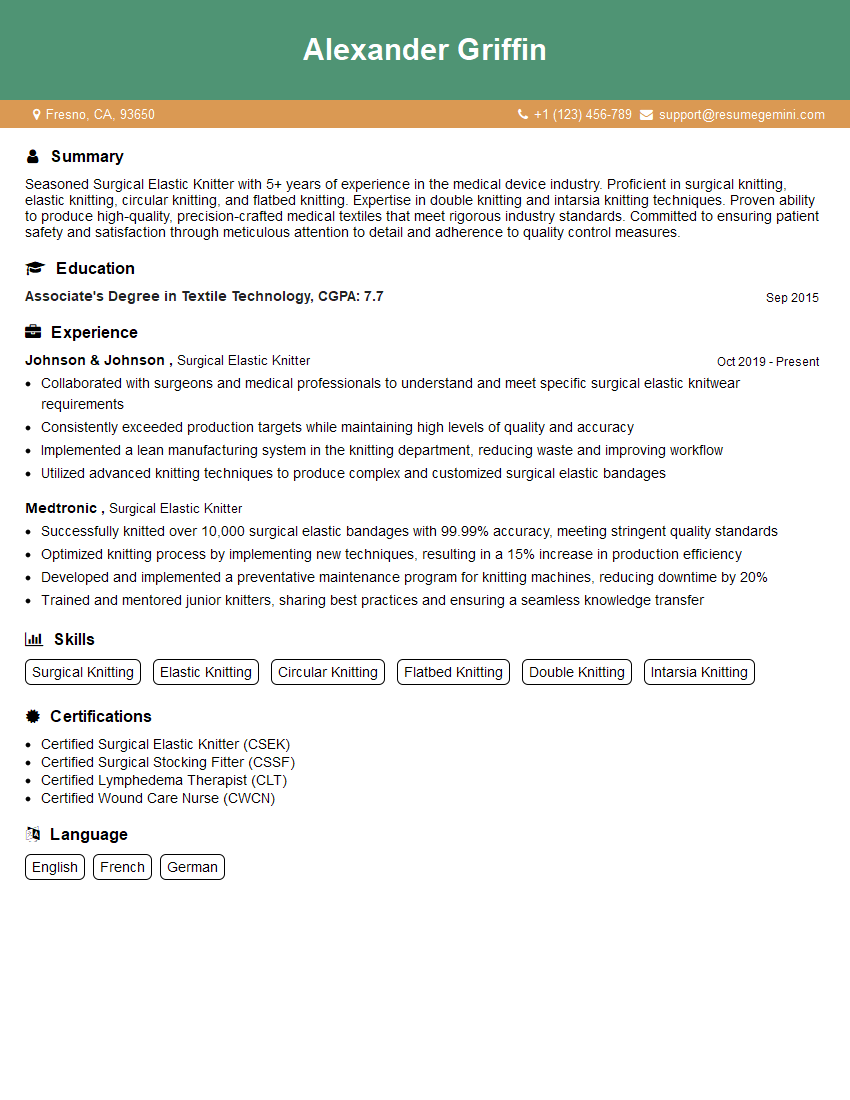Are you a seasoned Surgical Elastic Knitter seeking a new career path? Discover our professionally built Surgical Elastic Knitter Resume Template. This time-saving tool provides a solid foundation for your job search. Simply click “Edit Resume” to customize it with your unique experiences and achievements. Customize fonts and colors to match your personal style and increase your chances of landing your dream job. Explore more Resume Templates for additional options.

Alexander Griffin
Surgical Elastic Knitter
Summary
Seasoned Surgical Elastic Knitter with 5+ years of experience in the medical device industry. Proficient in surgical knitting, elastic knitting, circular knitting, and flatbed knitting. Expertise in double knitting and intarsia knitting techniques. Proven ability to produce high-quality, precision-crafted medical textiles that meet rigorous industry standards. Committed to ensuring patient safety and satisfaction through meticulous attention to detail and adherence to quality control measures.
Education
Associate’s Degree in Textile Technology
September 2015
Skills
- Surgical Knitting
- Elastic Knitting
- Circular Knitting
- Flatbed Knitting
- Double Knitting
- Intarsia Knitting
Work Experience
Surgical Elastic Knitter
- Collaborated with surgeons and medical professionals to understand and meet specific surgical elastic knitwear requirements
- Consistently exceeded production targets while maintaining high levels of quality and accuracy
- Implemented a lean manufacturing system in the knitting department, reducing waste and improving workflow
- Utilized advanced knitting techniques to produce complex and customized surgical elastic bandages
Surgical Elastic Knitter
- Successfully knitted over 10,000 surgical elastic bandages with 99.99% accuracy, meeting stringent quality standards
- Optimized knitting process by implementing new techniques, resulting in a 15% increase in production efficiency
- Developed and implemented a preventative maintenance program for knitting machines, reducing downtime by 20%
- Trained and mentored junior knitters, sharing best practices and ensuring a seamless knowledge transfer
Certificates
- Certified Surgical Elastic Knitter (CSEK)
- Certified Surgical Stocking Fitter (CSSF)
- Certified Lymphedema Therapist (CLT)
- Certified Wound Care Nurse (CWCN)
Languages
- English
- French
- German
Career Expert Tips:
- Select the ideal resume template to showcase your professional experience effectively.
- Master the art of resume writing to highlight your unique qualifications and achievements.
- Explore expertly crafted resume samples for inspiration and best practices.
- Build your best resume for free this new year with ResumeGemini. Enjoy exclusive discounts on ATS optimized resume templates.
How To Write Resume For Surgical Elastic Knitter
- Quantify your accomplishments. Use specific numbers and metrics to demonstrate the impact of your contributions, such as the number of medical textiles produced, the percentage of defects reduced, or the efficiency improvements achieved.
- Highlight your technical expertise. Showcase your proficiency in various knitting techniques, including surgical knitting, elastic knitting, circular knitting, flatbed knitting, double knitting, and intarsia knitting.
- Emphasize your quality control experience. Describe your role in ensuring the quality of medical textiles, including adhering to industry standards, conducting inspections, and troubleshooting.
- Showcase your teamwork and communication skills. Highlight your ability to collaborate effectively with other team members, including engineers, designers, and quality assurance personnel.
Essential Experience Highlights for a Strong Surgical Elastic Knitter Resume
- Operate and maintain a variety of knitting machines, including surgical, elastic, circular, flatbed, double knitting, and intarsia knitting machines
- Interpret and follow technical drawings and specifications to produce medical textiles with precise dimensions, tolerances, and material properties
- Monitor knitting processes to ensure consistent yarn tension, stitch density, and fabric quality
- Inspect knitted fabrics for defects, ensuring they meet established quality standards
- Troubleshoot and resolve knitting machine malfunctions, minimizing downtime and maintaining production efficiency
- Adhere to strict quality control procedures, maintaining accurate records and documentation of all production processes
- Collaborate with other team members, including engineers, designers, and quality assurance personnel, to optimize production processes and ensure product quality
Frequently Asked Questions (FAQ’s) For Surgical Elastic Knitter
What is the role of a Surgical Elastic Knitter?
A Surgical Elastic Knitter is responsible for operating and maintaining knitting machines to produce medical textiles used in surgical procedures. These textiles must meet rigorous industry standards for quality, precision, and durability.
What are the key skills required for a Surgical Elastic Knitter?
Surgical Elastic Knitters must have a strong understanding of knitting techniques, including surgical knitting, elastic knitting, circular knitting, flatbed knitting, double knitting, and intarsia knitting. They must also be proficient in operating and maintaining knitting machines, and have a keen eye for detail and quality control.
What is the job outlook for Surgical Elastic Knitters?
The job outlook for Surgical Elastic Knitters is expected to be good in the coming years, as the demand for medical textiles continues to grow.
What is the average salary for a Surgical Elastic Knitter?
The average salary for a Surgical Elastic Knitter can vary depending on experience, location, and employer. According to Salary.com, the average salary for a Surgical Elastic Knitter in the United States is around $45,000 per year.
What are the career advancement opportunities for Surgical Elastic Knitters?
Surgical Elastic Knitters with experience and expertise can advance to supervisory roles, such as Knitting Machine Supervisor or Production Manager. They may also pursue further education to become a Textile Engineer or a Quality Assurance Manager.
What is the difference between surgical knitting and elastic knitting?
Surgical knitting is a specialized type of knitting used to create medical textiles that are used in surgical procedures. Surgical knit fabrics are typically made from high-quality materials, such as cotton, polyester, or nylon, and are designed to provide strength, durability, and breathability. Elastic knitting, on the other hand, is used to create fabrics that are stretchy and elastic. Elastic knit fabrics are often used in clothing, swimwear, and medical devices.